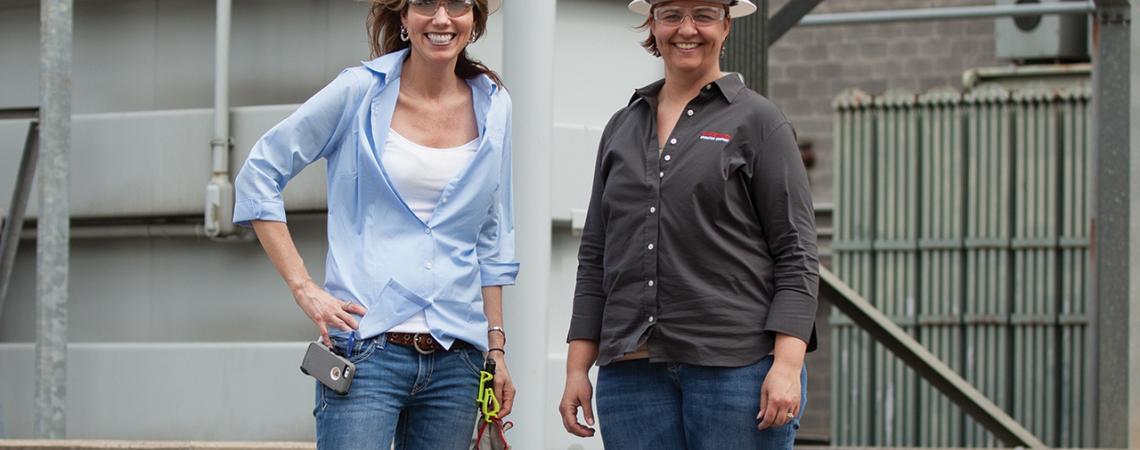Cardinal Plant Manager Bethany Schunn and Sustainability Lead Julie Jones say that actively seeking input from plant employees has led to more efficient operations there.
Part of the process of removing sulfur dioxide (SO2) from emissions at the Cardinal Power Plant involves the use of limestone. The process is complicated and can be messy, and when heavy deposits build up in the scrubber, the entire generating unit must come offline.
An employee at the plant suggested adding a chemical to the process that not only would allow for less limestone to be used, it would reduce those deposits in the scrubber — meaning lower maintenance time and cost.
It’s just one example of the kind of employee input that’s encouraged at the plant — even more so now since Cardinal Operating Company, overseen by Buckeye Power leadership, assumed operational control there from American Electric Power just over a year ago. Buckeye Power is the wholesale power provider for all 24 Ohio electric cooperatives, as well as one co-op based in Michigan.
“The partnership between AEP and Buckeye Power has been successful for many years, but the way AEP did things isn’t necessarily the way we do things,” says Pat O’Loughlin, CEO of Buckeye Power. “Cardinal was operated as part of their system, and their plants were operated in a common fashion. Today, we are focused on the best way to run this plant, and we are counting on our employees to help us find ways to eliminate waste and be more efficient.”
Finding those efficiencies was one of the benefits Buckeye Power hoped for when it began operating the plant. In the last decade, Ohio’s electric cooperatives have invested more than $1.2 billion in environmental safeguards — such as the scrubbers — that make Cardinal one of the cleanest coal-burning plants in the world.
Those investments resulted in increased cost to produce power between 2003 and 2013. Since then, however, those rates have remained relatively flat, and O’Loughlin says he expects that trend to continue for at least another year.
“When people see those rates stay about the same for that amount of time, they may think that means there’s not much going on to affect the rates, but in fact it’s taken a lot of work by a lot of people to make it happen,” he says.
In addition to generating power at Cardinal and at other plants around the state, Buckeye Power is also responsible for delivering it to the distribution substations at the local electric cooperatives. Because the co-ops own only a small percentage of the high-voltage transmission lines that carry electricity from the plant to the individual co-ops for distribution to their consumer-members, Buckeye Power’s wholesale rates are tied to the transmission rates charged by the investor-owned utilities that own those lines. Transmission owners are now investing heavily in line upgrades, and they’re passing a portion of the costs on to Buckeye Power and its members.
Transmission costs represent a smaller portion of the power costs than generation, but still have doubled in the last six years.
“We’ve been able to offset the rising transmission costs with reductions in fuel costs and the other costs associated with running the plant,” O’Loughlin says.
Fuel costs, generally, are fixed; with the closure of so many coal-fired plants in recent years, the price of coal has come down, at least temporarily. Some of the environmental investments at Cardinal have also allowed the company to use coal that’s mined locally, which is both less expensive to purchase and less costly to transport.
The new environmental controls have also allowed the company to turn some of the byproducts of the burning and scrubbing, which would otherwise go into a landfill, into sellable commodities, such as wallboard-quality gypsum or bottom ash that can be used to safely treat icy roads in the winter.
More savings are being found all the time, especially since company officials have begun enlisting employees for help. The chemical addition in the SO2 scrubbing process is just one example of such employee input.
“We actively solicit ideas from the employees — it’s just part of the culture here now,” says Julie Jones, sustainability lead at the plant. “We share a lot more information with them now, and in return, they’re taking an active role in finding places that we might be wasting money.
“It just makes sense because they’re on the front lines and see these things every day. They can help change it.”
Employee suggestions have led to other changes as well. Coal is handled more efficiently from the time it’s unloaded from barges until it’s loaded into the boiler. Employee input brought about the replacement of a conveyor belt that was constantly spilling coal, which was costly to clean up. That upgrade to a larger-size belt could save as much as $500,000 every year. Another suggestion led to operational changes that may allow the plant to generate less power overnight, when power is needed less and therefore, is less valuable.
“We are committed to our mission to deliver competitively priced, reliable power for the benefit of our 25 distribution cooperative members and their communities,” O’Loughlin says. “That, in turn, helps the local communities thrive in this challenging energy environment.”









